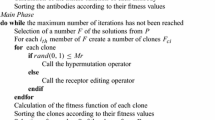Abstract
This paper aims to adapt the Clonal Selection Algorithm (CSA) which is usually used to explain the basic features of artificial immune systems to the learning of Neural Networks, instead of Back Propagation. The CSA was first applied to a real world problem (IRIS database) then compared with an artificial immune network. CSA performance was contrasted with other versions of genetic algorithms such as: Differential Evolution (DE), Multiple Populations Genetic Algorithms (MPGA). The tested application in the simulation studies were IRIS (vegetal database) and TIMIT (phonetic database). The results obtained show that DE convergence speeds were faster than the ones of multiple population genetic algorithm and genetic algorithms, therefore DE algorithm seems to be a promising approach to engineering optimization problems. On the other hand, CSA demonstrated good performance at the level of pattern recognition, since the recognition rate was equal to 99.11% for IRIS database and 76.11% for TIMIT. Finally, the MPGA succeeded in generalizing all phonetic classes in a homogeneous way: 60% for the vowels and 63% for the fricatives, 68% for the plosives.
Similar content being viewed by others
References
Bishop M. (1995) Neural networks for pattern recognition 1. Oxford University Press Inc., New York
Dasgupta D (1998) Artificial immune systems and their applications. Springer, Berlin
Dasgupta D, Ji Z, Gonzalez F (2003) Artificial immune system (AIS) research in the last five years. Congr Evol Comput 1: 123–130
De Castro LN, Von Zuben FJ (2000) The clonal selection algorithm with engineering applications. In: Workshop Proceedings of GECCO, pp 36–47
De Castro LN, Von Zuben FJ (2002) Learning and optimization using the clonal selection principle. IEEE Trans Evol Comput 6(3): 239–251
Decastro LN, Timmis J (2002) Artificial immune systems : a new computational intelligence. Springer, Berlin
Decastro LN, Von Zuben FJ (2001) Immune and neural network models: theoretical and empirical comparisons. Int J Comput Intell Appl(IJCIA) I 3: 239–257
Eiben AE, Smith JE (2003) Introduction to evolutionary computing. Springer, Berlin
Garofalo S, Lamel LF, Fisher WM, Fiscus J, GPallett DS, Dahlgren NL (1990) The DARPA TIMIT acoustic-phonetic continuous speech corpus CDR, NIST
Goldberg D (1989) Genetic algorithms in search, optimization and machine learning. Addison Wesley, Massachusetts
Haykin S (1998) Neural networks: a comprehensive foundation, 2nd edn. Springer, Berlin
Holland JH (1998) Adaptation in natural and artificial systems, 5th edn. MIT Press, Cambridge
Ishida Y (2004) Immunity based systems. Springer, Berlin
Jian PL, Balazs ME, Parks GT, Clarkson PJ (2002) A species conserving genetic algorithm for multimodal function optimization. Evol Comput 10(3): 207–234. doi:10.1162/106365602760234081
Junejia A, Wilson CE (2002) Segmentation of continuous speech using acoustic phonetic parameters and statistical learning. In: Proceedings of 9th international conference on neural information processing, Singapore, 2002, vol 2, pp 726–730
Karaboga D, Akay B (2009) A comparative study of artificial bee colony algorithm. Appl Math Comput 214(1): 108–132. doi:10.1016/j.amc.2009.03.090
Karaboga D, Okdem S (2004) A simple and global optimization algorithm for engineering problems: differential evolution algorithm. TUBITAK 12(1): 53–60
Lampinen J, Zelinka Y (2000) On stagnation of the differential evolution algorithm. In: Proceedings of MENDEL Conferens, pp 76–83
Linde Y, Buzo A, Gray RM (1980) An algorithm for vector quantizer design. IEEE Trans Comput 28(1): 84–95
Lydyard PM, Whelan A, Fanger MW (2000) Instant notes in immunology. BIOS, Oxford
Mesbahi L, Benyettou A (2005) A new look to adaptive temporal radial function basis function applied in speech recognition. J Comput Sci 01(1): 1–6
Neggaz N (2006) Apprentissage des réseaux de neurones par les algorithmes évolutionnaires appliquéà la classification phonétique, thesis, Deparment of Computer Science. USTO University os Oran, Algeria
Neggaz N, Tlemsani R, Benyettou A (2004) Evolutionary algorithms based neural networks training for phonetic classification. ACIT04, Algeria :1000–1006
Price KV, Storn RM, Lampinen JA (2005) Differential evolution : a practical approach to global optimization. Springer, Berlin
Seiffert U (2001) Multiple layer perceptrons training using genetic algorithm. Adelaide knowledge-based intelligent engineering systems center (KES), ESANN’01, Australia, pp 159–164
Sivanandam SN, Deepa SN (2007) Introduction to genetic algorithms. Springer, Berlin
Storn R, Price K (1997) Differential evolution a simple and efficient heuristic for global optimization over continuous spaces. J Global Optim 11: 341–359
Yao X (1999) Evolving artificial neural networks. IEEE Trans 87(9): 1423–1447
Author information
Authors and Affiliations
Corresponding author
Additional information
This work was supported by SIMPA laboratory.
Rights and permissions
About this article
Cite this article
Neggaz, N., Benyettou, A. Hybrid models based on biological approaches for speech recognition. Artif Intell Rev 32, 45–57 (2009). https://doi.org/10.1007/s10462-009-9132-7
Published:
Issue Date:
DOI: https://doi.org/10.1007/s10462-009-9132-7




